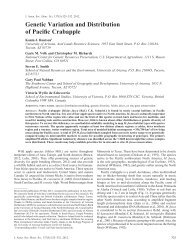CONSERVATION
Conservation You Can Taste - The Southwest Center - University of ...
Conservation You Can Taste - The Southwest Center - University of ...
- No tags were found...
You also want an ePaper? Increase the reach of your titles
YUMPU automatically turns print PDFs into web optimized ePapers that Google loves.
the testimonies of early adopters and innovators who nurtured their process of recovery. We<br />
also wish to highlight necessary cautions and avoid pitfalls that certain food recovery efforts<br />
have encountered. In other words, we hope to learn from our mistakes (and remedy them)<br />
as well as learn from the successes that appear to be potentially transferable to other foods<br />
at risk.<br />
Third, we wish to propose that new driving<br />
factors are emerging that are likely to propel heritage<br />
“Heritage foods offer a meaningful<br />
food recovery and food system diversification in<br />
dialogue between flavor, nutrition,<br />
new and unforeseen directions over the next quarter<br />
history and sustainability.” John Forti,<br />
century. New challenges are emerging as well. So<br />
Curator of Historic Landscape, Strawbery<br />
instead of thinking of food system diversification as a<br />
Banke Museum, Portsmouth NH<br />
rather “retro” effort in historic preservation or genetic<br />
conservation, we predict that future advances will take<br />
more dynamic and multi-cultural approaches.<br />
These novel approaches are likely to link these rare seeds and breeds to urban as<br />
well as rural food security, seed sovereignty, adaptation to climate change, alternatives to<br />
bioengineering and genetic contamination, and the quest for flavor, color and nutritional<br />
value. The role of heritage foods in providing nutrient diversity needs to be more widely<br />
recognized in the face oactor epidemic of obesity, diabetes and heart disease now affecting<br />
American youth.<br />
While we have no crystal ball, we feel it is morally necessary to broaden the discussion<br />
about heritage food recovery so that the needs of the poor, food insecure, nutritionallychallenged<br />
and politically-marginalized populations at risk are more fully taken into account.<br />
Already, efforts are underway to assure that heirloom vegetable seeds, seedlings and fruit<br />
tree cuttings are made more accessible for low-income families through “seed libraries” and<br />
SNAP program benefits, but there remains much more to be done. Thank you for joining<br />
us on this journey.<br />
11



